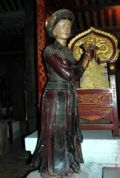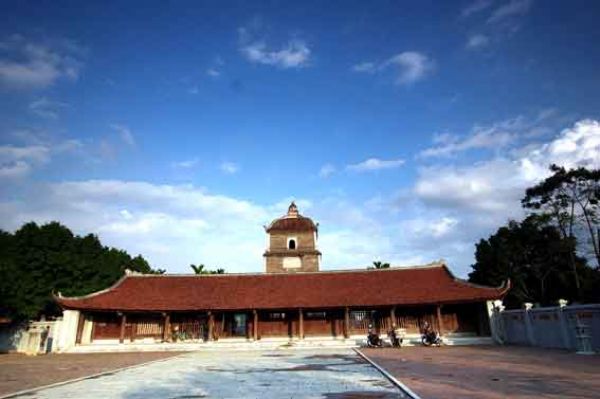 
Dau Pagoda is located in Thanh Khuong
village, Thuan Thanh district, Bac Ninh Province, about 30km from
Hanoi. Being a center of the ancient Luy Lau Citadel that dates back to
the second century A.D, this pagoda is considered the most ancient
religious structure and an initial source of Buddhism in Vietnam.
Through nearly two thousand years of ups and downs, the
present-day Dau Pagoda is quite different from its origin. In the old
days, a path led to the pagoda’s huge three-door gate and a spacious
flat field lying amid two ponds on which there is the reflection of a
roofed bridge with 9 spans. This type of bridge is also seen in the
ancient town of Hoi An (Faifo) in Central Vietnam and in some other
places.
Like many other pagodas in Vietnam , Dau Pagoda was built
with a traditional Oriental architecture. There are four rows of houses
that are connected to one another and stand in the shape of a
rectangular. They surround three main halls: the front hall, the middle
hall and the upper hall. The old back hall is no more in existence, but
visitors still see vestiges of the 40 small apartments divided into
two rows.
In the large front yard stands the Hoa Phong tower built with
large bricks. The bricks were baked at a high temperature that turned
them into glazed terra-cotta. Six layers on top of the tower were
damaged, but the other 3 layers from its base are still standing
firmly. The pagoda’s most ancient artefact was defined to exist under
the Tran Dynasty (1225-1400), and the first restoration was made in
1313 under the reign of King Tran Anh Tong.
The history of Dau Pagoda is recalled with a local legend. A
12-year-old girl named Man Nuong came to Linh Quang Pagoda (in
present-day Tien Du District) to become a nun. One day, when she was
sleeping, a monk named Khau Da La from Tay Truc (India) unintentionally
stepped over her. Man Nuong became pregnant and after 14 months she
gave birth to a baby. Before returning to Tay Truc, Khau Da La gave Man
Nuong a monk’s staff, together with some advice, i.e. when there was a
drought she would plant this staff in the soil and it would save
everyone. He also said some magic words for Man Nuong’s daughter and
put her in a cavity of a mulberry tree standing by the bank of the
Thien Duc River.

Dau Pagoda, the most
ancient pagoda and an initial source of Buddhism
in Vietnam. |
After Khau Da La left, a drought took place and lasted for
three years. Man Nuong planted the monk’s staff into the soil which
helped bring in rain. The mulberry plant fell down and it was carried
by the water flow toward the Luy Lau Citadel and finally reached to the
embankment where Man Nuong retrieved it. She ordered her assistants
to carve four statues as Buddhist guards from the tree and named them
after Phap Van (the Cloud Guard), Phap Vu (the Rain Guard), Phap Loi
(the Thunder Guard) and Phap Dien (the Lightning Guard). When the
carvers split open the tree, they found a stone and threw it into the
river. At night, the river bed was brilliantly lit. It turned out that
the stone was Man Nuong’s daughter. Man Nuong took the stone from the
river and placed it on the alter for worship and called it Thach Quang
(the Shining Stone). Later, Man Nuong was called by the locals the
Great Mother and she led a religious life at the main pagoda (called
Man xa), while the four Buddhist statues were worshipped in four
pagodas in the area.
According to monk Thich Dam Tuy, a 4th generation
verger , Dau Pagoda has several names, including Dien Ung Pagoda, Phap
Van Pagoda, Thien Dinh Pagoda and Co Chau Pagoda. It came into
existence with the legend about Man Nuong which helps researchers
understand the ancient culture of the Kinh Bac region. The area is
considered the confluence of two Buddhist cultures that came from India
and from the North.
There are 500 monks graduating from Dau Pagoda; 15 sets of
Buddhist prayers are translated, and dozens of towers built with
contributions made by the monks and nuns of the Dau Pagoda. Many
eminent bonzes, such as Mau Bat, Ti Ni Da Luu Chi, Khang Tang Hoi and
Phap Hien, came to Dau Pagoda and over time each became the master
bonze. Kings in older times often came to Dau Pagoda to escort the
procession bringing the Cloud Guard statue to Bao Thien Pagoda, now in
Hanoi , for a rain and wind praying ceremony.
Visitors to Dau Pagoda are much impressed with the statues
for worship, especially the statue of Ngoc Nu. It was made in the shape
of a young woman of this rural area famous for its duet-singing songs,
with a charming body, a simple but lovely kerchief on her head, and a
colourful four-panel dress with a long and soft silk waist band. At Dau
Pagoda, visitors witness the confluence of the original Buddhism as an
imported culture, its development as well as its spiritual values that
became well adapted to the Vietnamese life.
Dau Pagoda is located in a complex of many historic and
cultural sites of ancient values, such as Luy Lau Citadel by the Thien
Duc River, But Thap Tower having the Qan Yin statue (Buddha with one
thousand eyes and one thousand arms), Dong Ho Village with its
long-standing traditional craft of folk paintings, and the Duong River
where so many historical events have taken place. Due to its historical
and cultural values, Dau Pagoda has been restored and preserved by the
Vietnamese Government as well as the Vietnam Buddhist Shangha.
Story by Tri
Cong - Photos by Tien Dung, Cong Hoan
Source:
vietnam.vnanet.vn |